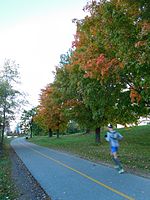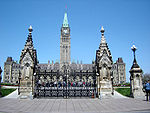Bytown Museum

The Bytown Museum (French: Musée Bytown) is a museum in Ottawa located in the Colonel By Valley at the Ottawa Locks of the Rideau Canal at the Ottawa River, just below Parliament Hill. Housed in the Commissariat Building, Ottawa's oldest remaining stone building, the museum provides a comprehensive overview of the origins of Bytown and its development and growth into the present city of Ottawa. Founded in 1917 by the Women's Canadian Historical Society of Ottawa (WCHSO), the Bytown Museum was originally located in the former City Registry Office at 70 Nicholas across from the Carleton County Gaol. The museum moved to its current location in 1951 and has operated from the Commissariat since, with the exception of a brief period from 1982 to 1985, when Parks Canada, the building's landlord, conducted renovations.
Excerpt from the Wikipedia article Bytown Museum (License: CC BY-SA 3.0, Authors, Images).Bytown Museum
Canal Lane, (Old) Ottawa Centretown
Geographical coordinates (GPS) Address Website External links Nearby Places Show on map
Geographical coordinates (GPS)
| Latitude | Longitude |
|---|---|
| N 45.425809 ° | E -75.697764 ° |
Address
Bytown Museum
Canal Lane 1
K1P 1C7 (Old) Ottawa, Centretown
Ontario, Canada
Open on Google Maps








